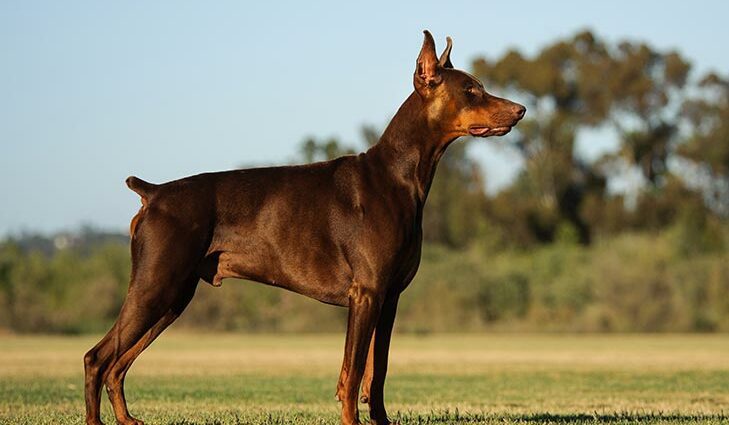Contents
Doberman
Physical Characteristics
The Doberman is a medium-sized dog, with a square, strong and muscular body. He has powerful jaws and a strong skull with small erect ears. Elegant and proud in appearance with a height at the withers of 68 to 72 cm for males and 63 to 68 cm for females. Its tail is set high and erect and its coat is short, hard and tight. Her dress is always black or brown. The limbs well perpendicular to the ground.
The Doberman is classified by the Fédération Cynologiques Internationale among Pinscher and Schnauzer. (1)
Origins and history
The Doberman is originally from Germany, and takes its name from Louis Dobermann de Apolda, a tax collector, who wanted a medium-sized dog capable of being both a good watchdog and a good companion. It is for this reason that around 1890, he combined several breeds of dogs to create the “Doberman Pinscher”.
Since then the Dobermans have been frequently used as guard dogs and herd protection, but also as police dogs, which earned them the nickname of “gendarme dog”.
During the Second World War, they were used as dogs of war by the American army and proved particularly useful during the battles of the Pacific and in particular on the island of Guam. Since 1994, a monument has been erected on this island to honor the memory of the Dobermans killed during the clashes of the summer of 1944. It bears the mention «Always Faithful» : always loyal.
Character and behavior
The Doberman Pinscher is known to be energetic, vigilant, courageous, and obedient. He’s ready to sound the alarm at the first sign of danger, but he’s also naturally affectionate. It is a particularly loyal dog and easily becomes attached to children.
He is obedient by nature and easy to train, even though he has a strong temper.
Frequent pathologies and diseases of the Doberman
The Doberman is a relatively healthy dog and, according to the UK Kennel Club’s 2014 Purebred Dog Health Survey, around half of the animals studied were unaffected by a condition. The leading causes of death were cardiomyopathy and cancer (type not specified). (3)
Like other purebred dogs, they are prone to developing hereditary diseases. These include dilated cardiomyopathy, Von Willebrand’s disease, panostitis and Wobbler’s syndrome. (3-5)
Dilated cardiomyopathy
Dilated cardiomyopathy is a disease of the heart muscle characterized by an increase in the size of the ventricle and thinning of the walls of the myocardium. In addition to these anatomical damage, contractile abnormalities are added.
Around the age of 5 to 6 years, the first clinical signs appear and the dog develops cough, dyspnea, anorexia, ascites, or even syncope.
The diagnosis is made on the basis of clinical examination and cardiac auscultation. To visualize the ventricular abnormalities and notice the contractile disorders, it is necessary to perform a chest x-ray, an EKG or an echocardiography.
The disease causes left heart failure which then progresses to right heart failure. It is accompanied by ascites and pleural effusion. Survival rarely exceeds 6 to 24 months after starting treatment. (4-5)
Von Willebrand’s disease
Von Willebrand disease is a genetic disease that affects blood clotting and more specifically the Von Willebrand factor from which it takes its name. It is the most common of inherited coagulation abnormalities in dogs.
There are three different types (I, II and III) and Dobermans are most often affected by type I. It is the most common and the least serious. In this case, the von Willebrand factor is functional, but decreased.
The clinical signs guide the diagnosis: increased healing time, bleeding and digestive or urinary haemorrhages. Then more in-depth examinations determine the bleeding time, the clotting time and the amount of Von Willebrand factor in the blood.
There is no definitive treatment, but it is possible to give palliative treatments which vary according to type I, II or III. (2)
La PanosteÌ ?? ite
Panosteiitis is an abnormality in the proliferation of bone cells called osteoblasts. It affects young growing subjects and affects long bones, such as the humerus, radius, ulna and femur.
The disease manifests itself by sudden and transient limping, changing location. The diagnosis is delicate because the attack evolves from one limb to another. The x-ray reveals areas of hyperossification in the middle part of the bones and pain is evident on palpation of the affected areas.
Treatment consists of limiting the pain with anti-inflammatory drugs and the symptoms resolve naturally before the age of 18 months.
Wobbler’s syndrome
Wobbler’s syndrome or caudal cervical spondylomyelopathy is a malformation of the cervical vertebrae that causes compression of the spinal cord. This pressure causes poor coordination of the legs, falls or mobility problems and back pain.
The x-ray can give an indication of damage to the spine, but it is the myelography that can locate the area of pressure on the spinal cord. It is not possible to cure the disease, but medication and wearing a neck brace can help restore the dog’s comfort.
See the pathologies common to all dog breeds. |
Living conditions and advice
The breed needs regular exercise, and only needs minimal grooming for their short coat.











Dobermans amerikyanne 11. amsakan.karelie tavari spitak epac toq ???